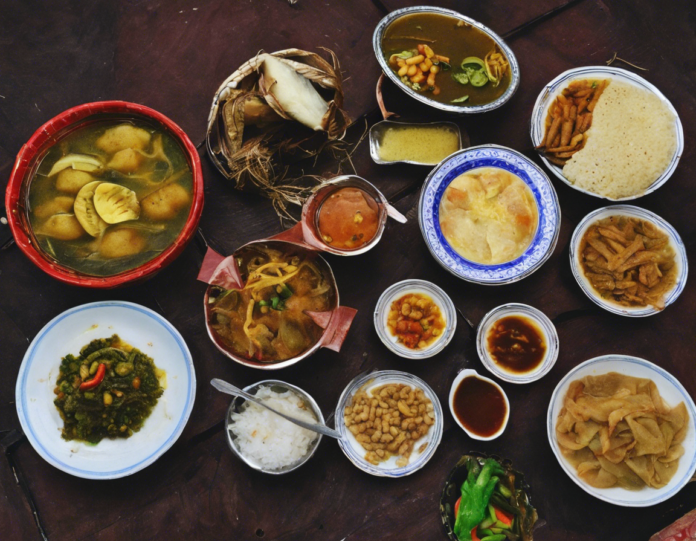Sikkim, a small state nestled in the lap of the Himalayas, is not only known for its breathtaking scenery but also its unique and delectable cuisine. The food of Sikkim is a reflection of its diverse culture and rich tradition. In this article, we will explore the various delicious delights that this charming state has to offer.
Introduction to Sikkimese Cuisine
Sikkimese cuisine is a harmonious blend of flavors from Nepal, Tibet, and India, making it a culinary paradise for food enthusiasts. The cuisine is characterized by the use of organic ingredients, simple cooking techniques, and a focus on health and well-being. Rice, meat, and dairy products are staples in Sikkimese meals, with a variety of spices and herbs adding depth and complexity to the dishes.
Must-Try Dishes
1. Momos
Momos are perhaps the most popular dish from Sikkim. These delectable dumplings are filled with a mixture of meat or vegetables and are often served with a spicy tomato chutney. Momos are a common street food and can be found in almost every corner of the state.
2. Thukpa
Thukpa is a hearty noodle soup that is perfect for the chilly weather in Sikkim. Made with wholesome ingredients like vegetables, meat, and noodles, this dish is a complete meal in itself. The warm and comforting flavors of Thukpa make it a favorite among locals and tourists alike.
3. Gundruk
Gundruk is a traditional fermented leafy green vegetable preparation that is popular in Sikkimese cuisine. The leaves are sun-dried and then fermented, giving them a unique tangy flavor. Gundruk is often used in soups and stews to add a distinctive taste to the dishes.
4. Phagshapa
Phagshapa is a wholesome pork dish that is slow-cooked with radishes and a variety of spices. The meat becomes incredibly tender, and the flavors are a delightful mix of savory and spicy. Phagshapa is often enjoyed with steamed rice, making it a satisfying meal.
5. Chhurpi
Chhurpi is a traditional Sikkimese cheese that is made from yak’s milk. This hard cheese is commonly used in dishes like soups and stews, adding a rich and creamy texture. Chhurpi is also enjoyed as a snack on its own, with a unique taste that is sure to please cheese lovers.
Food Culture and Customs
In Sikkim, food is more than just sustenance; it is a way of life. Hospitality plays a significant role in Sikkimese culture, and guests are always welcomed with open arms and a delicious meal. Traditional feasts are a common occurrence during festivals and special occasions, where a variety of dishes are prepared to be shared with family and friends.
Eating with your hands is a common practice in Sikkim, as it is believed to enhance the connection between the food and the eater. Tea is a staple beverage in Sikkim, with butter tea being a local favorite. This rich and creamy drink is perfect for keeping warm in the cold mountain climate.
Culinary Influences and Ingredients
Sikkimese cuisine has been influenced by its neighboring regions, resulting in a diverse array of flavors and ingredients. Rice is a staple food in Sikkim and is often served with every meal. Meat dishes are also popular, with pork, beef, and chicken being the most commonly consumed meats.
Spices and herbs play a crucial role in Sikkimese cooking, with ingredients like ginger, garlic, turmeric, and Sichuan pepper adding depth and complexity to the dishes. Fermented foods are also a significant part of the cuisine, with ingredients like gundruk and kinema being widely used in traditional recipes.
Health Benefits of Sikkimese Cuisine
Sikkimese cuisine is not only delicious but also nutritionally rich and healthful. The use of fresh and organic ingredients, minimal processing, and balanced flavors make Sikkimese food a wholesome choice for those looking to eat well. The emphasis on whole grains, vegetables, and lean meats ensures that Sikkimese meals are packed with essential nutrients and vitamins.
FAQs about Sikkimese Cuisine
1. What is the significance of momos in Sikkimese cuisine?
Momos hold a special place in Sikkimese cuisine as they are a popular street food enjoyed by locals and tourists alike. These dumplings are versatile and can be filled with a variety of meats and vegetables.
2. How important is tea in Sikkimese culture?
Tea is a staple beverage in Sikkim, with butter tea being a local favorite. Tea is often enjoyed throughout the day and is a symbol of hospitality and warmth in Sikkimese culture.
3. What are some must-try vegetarian dishes in Sikkim?
For vegetarian visitors, dishes like vegetable Thukpa, Sinki, and gundruk ko achar (fermented vegetable pickle) are must-tries to experience the diverse flavors of Sikkimese cuisine.
4. Are there any traditional desserts in Sikkim?
Yes, traditional desserts like Phini (a sweet, flaky dessert), Sel Roti (a sweet, deep-fried bread), and Khapse (deep-fried pastries) are popular in Sikkimese cuisine.
5. How can I experience Sikkimese cuisine if I am not able to visit Sikkim?
Many restaurants outside Sikkim serve Sikkimese dishes, especially in cities with a significant Nepali and Tibetan population. You can also try recreating Sikkimese recipes at home using authentic ingredients.
In conclusion, the food of Sikkim is a vibrant tapestry of flavors, textures, and traditions that reflect the rich cultural heritage of the region. From spicy momos to hearty Thukpa and flavorful Gundruk, Sikkimese cuisine is a delight for the senses. Whether you are exploring the streets of Gangtok or savoring a home-cooked meal, the culinary offerings of Sikkim are sure to leave you craving for more.
